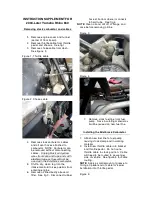
3
4
18B&OLRBIUDB*T[G 3DJH
CLIO nu665-3
C:\Documentum\Checkout\nu665-3_eng_T1.WIN 12/9/2001 11:03
- page 32
q
1.24
CHILD SAFETY
(continued)
Category 2 (15 to 25 kg)
(33 to 55 lbs)
The type of restraint most suitable
for the pelvis of a child aged
between 4 and 7 is one that can be
combined with a three-point seat
belt. This is a booster seat (figure 3)
with belt guides to ensure that the
belt will be worn flat over the thighs
of the child.
A booster seat with a height-
adjustable seatback and a belt guide
are recommended as this will allow
the belt to be worn as close to the
base of the neck as possible but not
on it. A bucket-type seat (figure 4)
must be used for cars where the rear
centre seat is equipped with a
two-point belt.
Category 3
For children aged over seven, a
booster seat with belt guides is
recommended to ensure that the
car's three-point seat belt will be
worn flat over the child's thighs.
A
booster
seat
with
a
height-adjustable seatback and a
belt guide are recommended as this
will allow the belt to be worn as
close to the base of the neck as
possible but not on it.
If a booster seat without a seatback
is used (figure 4), the car's head
restraint must be adjusted to suit the
child's stature; the upper edge of the
head restraint must be at the same
height as the top of the child's head
and should never be lower than the
level of the child's eyes.
















































